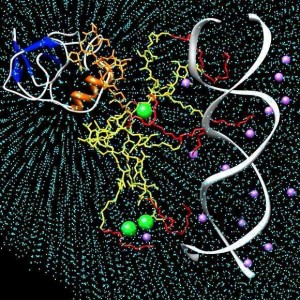
Dendritic molecules are hyper-branched polymers, characterized by a regular and periodic structure, highly controllable in their chemical and structural properties. The chemical functionalization of the surface became in the last years a key point in the use of these molecules as potential nano-carriers for the delivery and release of genetic materials into cells. They owe their extremely high potential of DNA/RNA binders to their multivalent charged surface, that is strongly characterized and controlled by the dendritic scaffold. The multiple recognition between the multi-charged surface and the negative charges present on the strands of the nucleic acid allow the creation of ultra-high affinity binding due to the principle of multivalency. We used molecular dynamics approaches to explore the ability of these molecules to bind DNA and siRNA and to understand the mechanism of this process. With modeling we are able to provide insight in the structure behavior to aid our experimental to design and develop improved and more efficient structures to bind and release nucleic acids into cells.
More recent publications:
– F. Stojcevski, G. Grasso, L. Pallante, A. Danani, “Molecular and Coarse-Grained Modelling to Characterize and Optimize Dendrimer-Based Nanocarriers for siRNA Delivery”, ACS Omega (2020) Feb 7;5(6): 2978-2986; DOI: 10.1021/acsomega.9b03908
– M. A. Deriu, N. Tsapis, M. Noiray, G. Grasso, N. El Brahmi, S. Mignani, J.P. Majoral, E. Fattal, A. Danani, “Elucidating the role of surface chemistry on cationic phosphorus dendrimer–siRNA complexation”, Nanoscale, 2018, 10, 10952 – 10962 
– G. Grasso, M.A. Deriu, V. Patrulea, G. Borchard, M. Möller and A. Danani, “Free Energy Landscape of siRNA-polycations complexation: elucidating the effect of molecular geometry, polymer flexibility, and charge neutralization”, PLOS ONE, October 31, 2017 https://doi.org/10.1371/journal.pone.0186816 
Back to Research ongoing

![]()
![]()